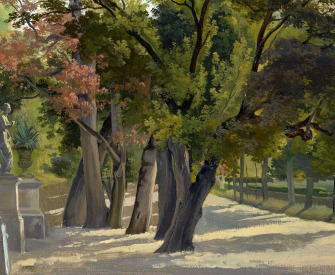Nothing more wonderfully beautiful can exist than the Arctic night.
It is dreamland, painted in the imagination’s most delicate tints; it is color etherealized. One shade melts into the other, so that you cannot tell where one ends and the other begins, and yet they are all there. No forms—it is all faint, dreamy color music, a faraway, long-drawn-out melody on muted strings. Is not all life’s beauty high and delicate and pure like this night? Give it brighter colors, and it is no longer so beautiful. The sky is like an enormous cupola, blue at the zenith, shading down into green, and then into lilac and violet at the edges. Over the ice fields, there are cold violet-blue shadows, with lighter pink tints where a ridge here and there catches the last reflection of the vanished day. Up in the blue of the cupola shine the stars, speaking peace, as they always do, those unchanging friends. In the south stands a large red-yellow moon, encircled by a yellow ring and light golden clouds floating on the blue background. Presently, the aurora borealis shakes over the vault of heaven its veil of glittering silver—changing now to yellow, now to green, now to red. It spreads, it contracts again, in restless change, next it breaks into waving, many-folded bands of shining silver, over which shoot billows of glittering rays; and then the glory vanishes. Presently, it shimmers in tongues of flame over the very zenith; and then again it shoots a bright ray right up from the horizon, until the whole melts away in the moonlight, and it is as though one heard the sigh of a departing spirit. Here and there are left a few waving streamers of light, vague as a foreboding—they are the dust from the aurora’s glittering cloak. But now it is growing again; new lightnings shoot up; and the endless game begins afresh. And all the time this utter stillness, impressive as the symphony of infinitude. I have never been able to grasp the fact that this earth will someday be spent and desolate and empty. To what end, in that case, all this beauty, with not a creature to rejoice in it? Now I begin to divine it. This is the coming earth—here are beauty and death. But to what purpose? Ah, what is the purpose of all these spheres? Read the answer if you can in the starry blue firmament.
From Farthest North. In 1882 the twenty-one-year-old Nansen—who had recently been appointed curator of zoology at the Bergen Museum—developed an interest in Arctic oceanography. Eleven years later he embarked on this expedition, breaking the record for highest latitude reached by humans and also proving that a ship could safely traverse the frozen Arctic Sea by intentionally becoming trapped in slow-moving sea ice. On his 1896 return to Norway, Nansen became an immediate celebrity.
Back to Issue





